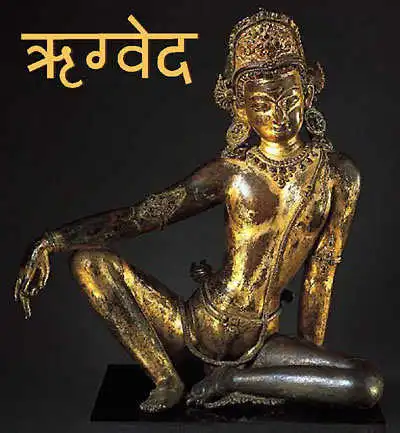
The Creation in Rig Veda 10:129Max Müller's Translation
Max Müller's Version of Rig Veda 10:129The German philologist and Orientalist Max Müller (1823-1900), who spent most of his academic life in England, compiled a Sanskrit edition of the Rig Veda between 1849 and 1874, whereof the 10th mandala was published in 1862. He also published an English version of Rig Veda 10:129 in his book A History of Ancient Sanskrit Literature (London 1859, p. 564).
Müller seems not to have done the translation by himself, since he writes rather cryptically: "I subjoin a metrical translation of this hymn, which I owe to the kindness of a friend." (p. 563) No name is given, nor is it explained if the friend helped with the translation of the Sanskrit original or only with the metrics in English. I would assume the latter. Here is his translation of Rig Veda 10:129 in full. Unlike the other translators of the hymn, Max Müller made no division into verses. It is evident that the metrical effort has twisted things here and there, as can be seen when comparing with other versions, but the subject-matter mostly remains quite the same also in the details.
Rig Veda, Mandala 10, hymn 129Creation. Nasadiya Sukta ("Not the non-existent")
Unfortunately, this version is not complete. Parts of the hymn text he settles for explaining without quoting. Both the extant quotes and his comments will be referred to below.
Not even nothingThe Rig Veda 10:129 hymn starts off by establishing just how incomprehensibly empty it was before creation. Neither something nor nothing existed. The hymn presents them as opposites in need of one another, like the two sides of a coin.In his straightforward version, Max Müller puts it differently from above: "Nothing that is, was then, even what is not, did not exist then." (p. 559) That alters the meaning slightly. This quote simply suggests that what does not exist now didn't exist back then, either. The metrical version stays with the paradox of the original state being void even of nothing. The latter is also supposed by other translations of the hymn. The confusing opening statement plays with the idea that if nothing exists, then there is nothing missing that could be something. If nothing is a state lacking something, then something is needed for nothing to lack something else. Otherwise they both lack any meaning. It raises the questions discussed also by the philosophers of Ancient Greece: Can there be nothing, and can something come out of nothing? These dilemmas hide in any concept of the world having an origin, before which it was not.
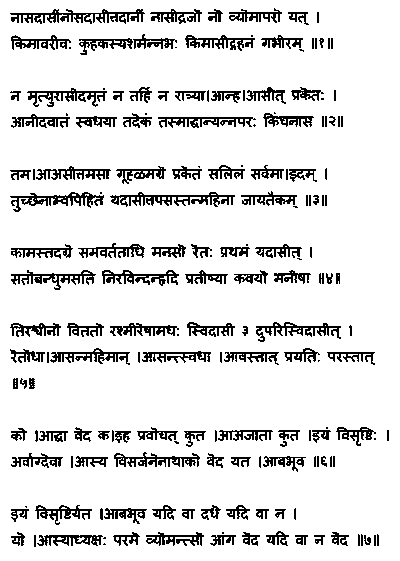 Rig Veda 10:129 in Sanskrit.
Many other ancient cosmologies — from myth as well as philosophy — picture the sky as a solid thing surrounding the world, with the sun, the moon and the stars moving about much like men walk on earth. This made the most sense in a geocentric world view, i.e. with the earth in the center, and anything else would have been very difficult to imagine before astronomy proved that also the earth moves.
No Primordial SeaThe abyss of water mentioned in the fourth line is a very familiar concept in creation myths — the primordial sea out of which the world was thought to emerge. To ancient man, the sea was the most persistent of all: endless, unchanging, deeper than eyes could reach, surrounding all land.All creatures died eventually, trees withered and fell, mountains eroded, even the celestial lights sometimes behaved unpredictably, but the sea seemed completely unaffected. So, most traditions regarded the sea as eternal. This Rig Veda hymn dares to question that. Not deny it, but question it. If there was a state before the creation of the world, would there even be a primordial sea in it?
No ImmortalsIn this primordial nothing there were neither mortal nor immortal beings, the hymn claims. The latter is a very radical statement of a mind from 3,000 years ago or more. It would have been equally radical, up until a couple of hundred years before our present time.The notion of what we somewhat inaccurately call gods has been an important part of the human world view almost all through civilization, and in most if not all cultures of the world. In human thought as far back as we have it recorded, except for the last few centuries, the concept of a world without divine creatures, conscious beings outside the palpable existence, has been almost unfathomable. So much in nature suggested already to primordial man that there is more to life than what the eyes can see. Things move in heaven and on earth, without visible means. Also, there is the mystery of the human mind, full of memories and dreams. Primordial man could not compute it all without imagining invisible active forces, which therefore must have awareness and intention or they would do nothing. What we today describe as natural laws were given divine features by primordial man observing their effects, simply from the lack of finding any more plausible explanation to them.
The OneSo, the Rig Veda hymn makes a mental leap suggesting the absence of such divine entities in the state before creation. But the hymn is not what we would call atheistic, since it soon introduces "the One" as the only thing somehow present in this primordial nothing.This One is not described in any detail, but the hymn makes it the creator, or initiator, of the world to emerge. It's the agent of the creation, that necessary something or someone without which nothing could happen. A primus motor, a first cause, as Aristotle would have it. For something to start to happen, something else must cause it. The poet of this hymn implies the same, although vaguely. The One is breathing breathlessly in itself, which is sort of a metaphor for the paradox of something existing in nothing, before the creation. It's what we would call a potential, yet unmanifested. Something that can happen but still hasn't done so. In his comments, Max Müller elaborates on this line, giving it an alternative interpretation. He does so within quotes, as if the Rig Veda hymn line could also be translated accordingly, which is doubtful and not repeated by other translators: "That One breathed, and lived; it enjoyed more than mere existence; yet its life was not dependent on anything else, as our life depends on the air which we breathe. It breathed breathless." (p. 560) Breathing is a universal sign of being alive, which in turn is a prerequisite for being a primus motor, a starter of what never happened before. This has been discussed by Plato in his theory of ideas. He stated that forms have to exist as possibilities before they can turn into physical shapes, much like there has to be an idea of what to do or make before doing or making it. In Plato's eyes, when a seed grew into a tree it was simply filling a predetermined form. Like in casting, when floating metal fills the mold. He could not see how else one thing could transform into another. That's not far from the truth, as described by our present science: The final form of any living thing is already decided by its genetic compound. To the ancient mind, evidently also that of the poet of this hymn, creation of something new must start as an idea, an intention, in its source. The world must be wished before it can be created. The hymn later explores what might have given birth to that wish in the One.
Now, a Primordial SeaThe primordial ocean is mentioned again in the tenth line of the hymn, establishing its existence, contrary to the doubts expressed in line four. This inconsistency needs to be pondered.Why would the poet of the hymn first doubt the existence of what he later takes for granted? It is because he is in need of a setting, a stage for what is to come. We may have trouble seeing an uncreated world filled with water, but the primordial sea is a dead one, in the midst of darkness. It is better seen as a space in which a world can appear, than as one ingredient in that world. In the many creation myths where it's the initial state, the word chaos is often used of it, as if synonymous. The Greek word implies a vast void, a gap renounce of any structure, sort of like a melting pot. That can also be described as chaotic, in our normal use of the word, since it is formless and nothing is yet possible to emerge from it.
The Germ and the IgnitionThe Rig Veda 10:129 hymn strongly suggests something like that chaotic sea as the original state. And the One is described as a germ, the potential of something growing, in that water.Max Müller compares the germ of the hymn to spring, the season bringing new life to the world: "The beginning of the world was conceived like the spring of nature; one miracle was explained by another." (p. 561) Spring is mentioned specifically in the hymn, but I've only found that to be the case in Müller's translation.
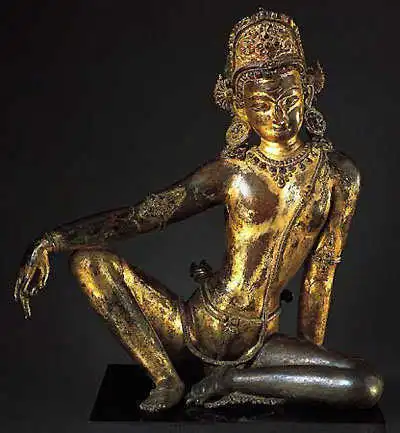
Awakened by DesireThe hymn says that something happened in that primordial sea. It started with heat, as if something was ignited. This is intriguingly near our modern understanding of the Big Bang birth of the universe, but in the hymn it should primarily be seen as the expression of an ingredient necessary to create life and to sustain it.In the cold of the primordial abyss, nothing can come to life. Heat is needed, however it arrives, for a living world to be born. Heat as nothing more than a prerequisite is confirmed by the next line of the hymn. Love enters. Other translations use the word desire, which is probably more adequate: the will to create life, to make something out of that dark abyss and turn it into a more pleasing habitat. Müller, too, uses the word desire repeatedly in his discussion of the line in the Rig Veda 10:129 hymn. Like the other translators, he sees the resemblance to human reproduction: "A substance without this life, without that infinite desire of production and reproduction, could hardly be said to exist." (p. 562) Another word that would fit as the driving force behind a conscious creation is longing. The One is alone in the abyss, awakened by the heat and thereby experiencing a longing for the world to emerge. This can be seen, implicitly or explicitly, in many other creation myths. The being responsible for the creation initiates it out of loneliness.
Something Out of NothingWhile the hymn has explained why creation commenced, it is yet to state how it took place. This is done in the following lines, starting by pointing out how this question has bewildered the minds of poets. They are called sages in other translations. To the writer of the hymn it probably made no difference.The poets or sages pondering this question have realized the relation between the created and the uncreated, or the existent and the non-existent. It's a tricky one, because if nothing exists then nothing can be said not to exist. The one needs the other, or we are back in the chaos of the primordial sea. So, we have the igniting heat and the desire awakening — then the realization that nothing can be turned into something, since the one implies the other. Creation is accomplished by merely recognizing this relation and making use of it. Several Greek philosophers discussed intensely if something can come out of nothing, seeing them as incompatible opposites. It had to be one or the other, no transformation from one to the other. But the initial nothing implied in the Rig Veda 10:129 hymn is not the opposite of something, since it is impossible for one to be the womb of the other. Instead, it describes a setting and a soup in which both nothing and something appear as each other's opposite. Something is created by nothing being created simultaneously, or none could. Instead of nothing and something, it might be more relevant to describe the polarities of this hymn as absence and presence. When something is present, immediately it is absent everywhere it's not present, and vice versa. It could also be stated as nothing being impossible without something, which might very well be what the sages or poets of the Rig Veda hymn realize. Then creation is immediately commenced out of logical necessity, since neither can exist without its counterpart. That suggests an interesting Big Bang theory: a world created immediately, because there just can't be nothing without something. Since there cannot even be nothing without something as its counterpart, a big bang of some sort has to happen. This would make sense also to the poet of Rig Veda 10:129, who however added an agent, an instigator in the form of desire — or love, as Max Müller would have it.
Heaven and EarthThe question that follows in Rig Veda 10:129 is where the initial spark may have come from, earth or heaven. It is puzzling in this setting. Neither existed when heat ignited something in the primordial sea. Max Müller also confesses his confusion about this line of the hymn: "We hardly know into what new sphere of thought the poet enters." (p. 562)Other translators substitute the spark for a ray or a cord, altering the meaning of the line substantially. In their versions, it's the instrument by which the high is separated from the low, heaven from earth, with the divine ruling forces in the former and the ruled creatures of the world on the latter. That may be more accurate than Müller's interpretation. But his translation, too, includes the division into high and low. In his comments, he also mentions a "ray of light" as an alternative translation (p. 562).
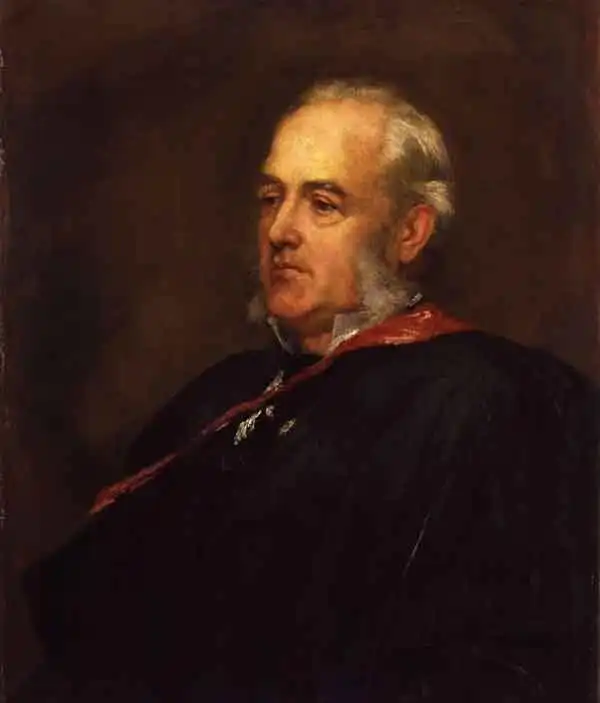 Max Müller. Painting by George Frederic Watts, 1895. As the Rig Veda hymn continues, the question seems to be rhetorical, rebuffing other theories about the creation that involve heaven and earth. The hymn declares that something started it, and arranged it so that the power of will was above and nature, the physical creation, was below as a receiver or mold on which that power continued the process. What the hymn seems to suggest, also in Max Müller's version, is that after the initial spark, the world was divided into heaven and earth, with the former as the sovereign and the latter its subject. This, too, is a very common world order in creation myths. Heaven rules earth, not the other way around. The sky is regarded as the abode of the powers that shape and govern the world. Well, essentially, that's also how we see it in an astronomical perspective. What the hymn insists, though, is that neither heaven nor earth existed at first. Creation started without them, so they must also have been created by that initial impulse.
The Only One Knowing — or NotThe hymn returns to the question of what was the first impulse of the creation, what was the true origin of it. The very start. Not even the gods would know, the hymn boldly states, since they, too, were absent at that moment.This statement is not as radical as it may seem in a monotheistic perspective. Most mythologies have a succession of gods, some even dying by the hands of others. Gods are born and have parents. That's quite the norm in polytheistic traditions. So, they can't all have been present in the very beginning. Only the one initiating it could. That's what the hymn states. Max Müller regards this primordial divinity as a new character introduced in the hymn: "the poet now speaks of an Adhyaksha, an overseer, a contemplator, who resides in the highest heavens." (p. 563) Müller calls this overseer "the source of creation," whether intentional or unintentional. I can't see that the hymn specifies a new being in these lines, neither in Müller's translation nor the other versions. The most immediate interpretation would be that this refers to the One mentioned earlier in the hymn. This one highest and earliest of gods, out of whom creation sprung whether that being willed it or not, is the only one who can know how it all began. Because he was the only one there. Then again, maybe even he doesn't know it. The last sentence is the punch line that most likely triggered the whole hymn to be written. The only one who can know might not know. That's how hidden and mysterious the creation of the world is. In his comments, Max Müller suggests two slightly different ways of translating the last few words: "They either mean 'Or does he not know?' and this would be a question of defiance addressed to all who might doubt his former assertion; or they mean 'Or he knows not,' and this would be a confession of doubt on the part of the poet." (p. 563) Not a very big difference in essence, since both versions accept the possibility to doubt the existence of that elevated divinity.
The Embryo of a GodBut the line plays another role than questioning the existence of a supreme deity. Instead, it points out that even such a sovereign may be unaware of how the world began. It's a consequence of the paradox of creation: the world born without a world to be born in. A beginning that must still have had a past, to which it could not belong although it could not spring into being without it. These paradoxes continue to play tricks on our minds.Why would not the initial creator god, if that's at all a relevant description of the One mentioned in the hymn, be aware of the creation and how it happened? Rig Veda 10:129 is possible to interpret as implying that the One was but a seed, a possibility, at that primordial state — not a knowing sovereign of it. He became aware when ignited by the heat, but was not the cause of it. A dormant god, or the seed of a god, like an embryo, yet unborn. Such a god would be ignorant of the very beginning, although being part of it. Already by mentioning that the other gods were not present from the start, the hymn makes it possible that also the first of them may have been caused by something else, a possibility in the primordial state. It touches the question relevant also in monotheism: Who created the creator god? That question is not alien to the poet of this hymn. Indeed, it's most likely what inspired the hymn in the first place.
About H. H. Wilson's Translation of Rig Veda 10:129The Creation in Rig Veda 10:129The Paradox of Origin
MENUCreation Myths Around the WorldHow stories of the beginning began.
The Meanings of MythologyTheories through history about myth and fable.
Archetypes in MythsThe mythological symbols and what they stand for.
The Logics of MythPatterns of creation.
CREATION MYTHS IN DEPTHCreation in Rig Veda 10:129The paradox of origin, according to an Indian myth.
Genesis 1The first creation story of the bible scrutinized.
Enuma ElishThe ancient Babylonian creation myth.
Xingu Creation of ManThe insoluble solitude of gods and humans.
ContactAbout Cookies
ON MY OTHER WEBSITESPsychoanalysis of MythWhat Sigmund Freud and C. G. Jung thought about myths, their origins and meanings.
Myth of CreationAn introduction to the subject of creation myths and the patterns of thought they reveal.
Cosmos of the AncientsWhat the Greek philosophers believed about the cosmos, their religion and their gods.
Life EnergyThe many ancient and modern life force beliefs all over the world explained and compared.
TaoisticTaoism, the ancient Chinese philosophy of life explained. Also, the complete classic text Tao Te Ching online.
|
 Archetypes of Mythology
Archetypes of Mythology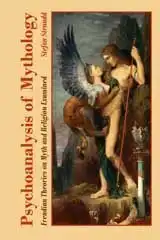 Psychoanalysis of Mythology
Psychoanalysis of Mythology Cosmos of the Ancients
Cosmos of the Ancients Life Energy Encyclopedia
Life Energy Encyclopedia Sunday Brunch with the World Maker
Sunday Brunch with the World Maker Fake Lao Tzu Quotes
Fake Lao Tzu Quotes Stefan Stenudd
Stefan Stenudd